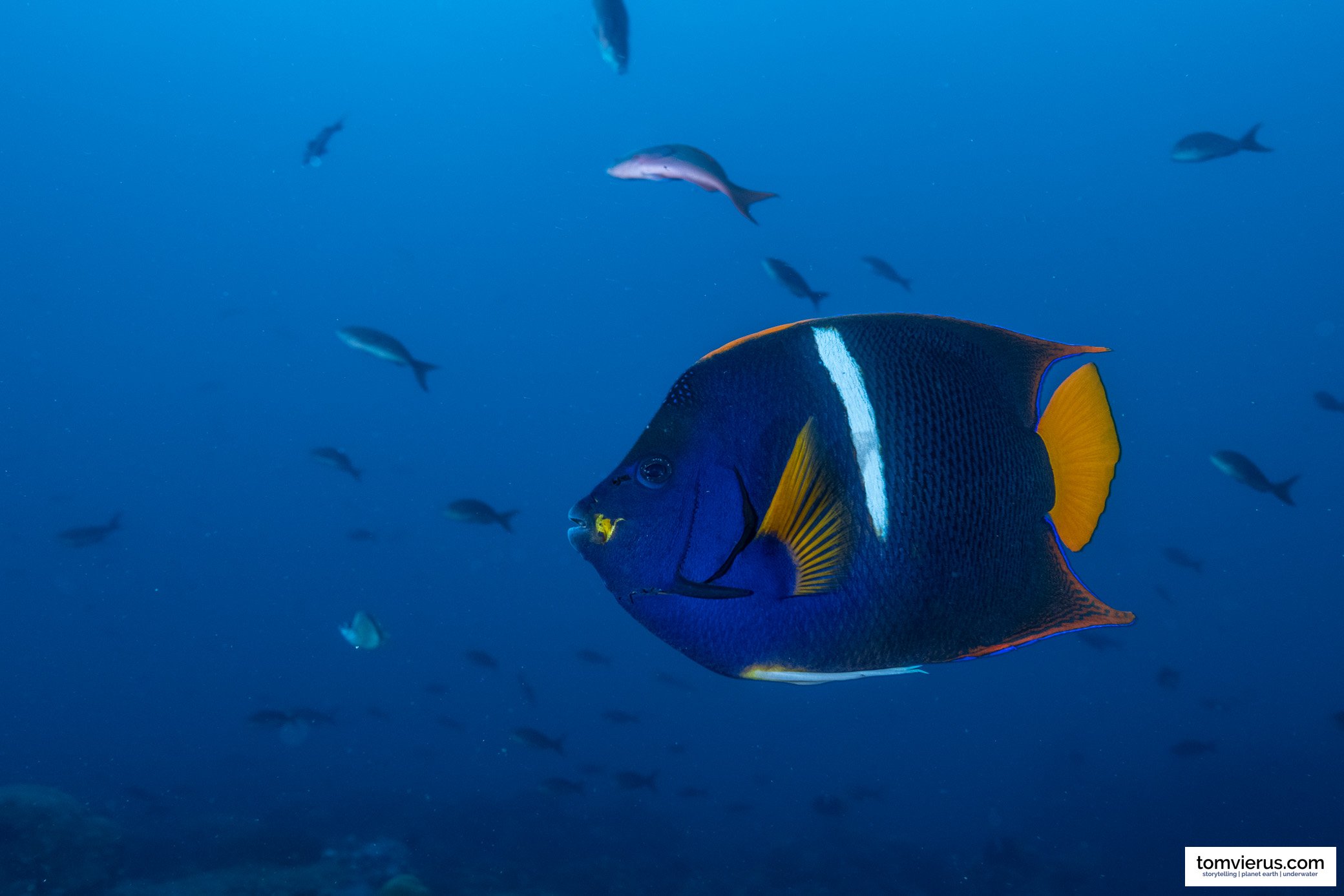Galápagos Diving from a Photography Perspective | Darwin's Arch | Part 4
This series of posts is about an 11-day liveaboard trip throughout the Galápagos Islands aboard the Deep Blue with the Master Liveaboard Fleet. Having shot several thousand images, I thought I would share a few more here than on my other social channels, but be sure to check out my Instagram, TikTok, Youtube, and Twitter for more. This part is about the second day of diving at the legendary Darwin's Arch. Have a look at the other posts in this series.
Panorama image of Darwin’s Arch in the northern part of the Galapagos Archipelago. The iconic rock formation collapsed due to erosion in mid-2021.
A diver sits on a rock and enjoys the passing by of a large school of Bigeye Trevallies (Caranx sexfasciatus).
A large school of Bigeye Trevallies (Caranx sexfasciatus).
Schools of hammerhead sharks at Darwin's Arch
A school of Scalloped Hammerhead Sharks (Sphyrna lewini) passes by in the blue waters surrounding Darwin’s Arch. Scalloped Hammerhead Sharks are classified as ‘Critically Endangered’ by the International Union for Conservation of Nature (IUCN).
A school of Scalloped Hammerhead Sharks (Sphyrna lewini).
A green sea turtle (Chelonia mydas) swims along a coral reef near Darwin’s Arch in the Galapagos Islands.
After a fantastic first day of diving at the famous Darwin's Arch, we got to do it all over again the following day. Here at Darwin, there is only one entry point, which is very close to the actual arch rock formation, but there are a few ways the dive may proceed depending on the currents. We would either just stay around the Arch or could drift towards actual Darwin Island through a beautiful sandy valley where - if the visibility was right - we could drift through larger schools of hammerheads. Indeed, that was what happened to us, with the minor caveat that the visibility wasn't as clear as I wanted it to be. Nevertheless, it was amazing. It always seemed that the sharks themselves were just as surprised to see us as we were to see them.
Fishermen besides our liveaboard?!
A small local fishing boat fishing the waters just off Darwin’s Arch in the northern part of the Galapagos Islands. I was quite surprised to see this small boat fishing right next to the dive site in plain sight, as I assumed the Galapagos National Park prohibits any kind of commercial fishing. According to the Darwin Foundation, there are currently over 1200 fishing licenses granted by the reserve.
A larger Leather Bass (Dermatolepis dermatolepis).
Portrait of a King Angelfish (Holacanthus passer).
During our surface interval, it was a bit odd to repeatedly observe a local fishing boat fishing only a few hundred meters away from us. The same boat, along with two more, we had already seen at Wolf Island a few days before. I haven't looked properly into it, but it seems like there are a few hundred fishing licenses for local fishermen who can fish around here. Previously, under the leadership of Ecuador's Ex-President, we were told the whole area around Wolf and Darwin was designated a No-Take Zone, which was changed again by the current president and opened up to fishing by locals.
Another whale shark!
Portrait of a King Angelfish (Holacanthus passer).
A Pronghorn Spiny Lobster (Panulirus penicillatus) looks out its rock hole.
A Needle Sea Urchin (Diadema mexicanum).
A giant hawkfish (Cirrhitus rivulatus).
Several dozen Galápagos Garden Eels (Heteroconger klausewitzi) on a sandy area.
A large Fine-spotted Moray (Gymnothorax dovii) freely swims along the algae-overgrown rocks in the waters surrounding Darwin’s Arch in the Galapagos Archipelago. These morays are common in this area and frequent sightings during dives.
Time to say goodbye to Darwin’s Arch – it indeed was an incredible time, and the eight dives here were mostly just insane!
A hard coral-dominated reef near Darwin’s Arch in the Galapagos Islands.
In Germany, we have a saying that all good things come in three and having missed the third whale shark from the previous day, the oceans gifted me the third sighting on our second day here. Again, the visit was of a quick nature, simply due to the incredible speed at which the whale sharks swim at, but I could take a nice silhouette shot of this magnificent animal. The first one was definitely the largest, but no whale shark sighting ever disappoints..
Galápagos Islands Series
The next stop will again be Wolf Island, with lots of spotted eagle rays and more hammerhead shark sightings! For now, have a look at the other posts in the Galápagos series below!

















